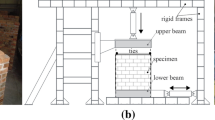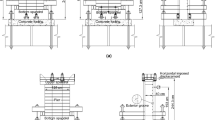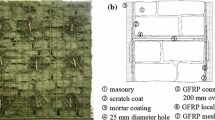Abstract
The paper presents the numerical results obtained testing a series of masonry panels. The experimental campaign is characterized by some in-situ diagonal compressive tests performed on both unreinforced and reinforced walls with overall dimensions equal to 1000 × 1000 × 300 mm3. The present study is intended to analyze from a numerical point of view, the behavior of ancient double wythe brick masonry panels subjected to in-plane diagonal compressive loads. To this scope, two different types of strengthening have been applied on the tested walls: (i) TRM (Textile Reinforced Mortar) materials symmetrically applied on the panel and (ii) an asymmetric reinforcement made with a layer of TRM materials and with a NSM (Near Surface Mounted) technique on the other. A series of numerical analyses have been carried out by means of a sophisticated heterogeneous micro-modeling technique, by means of which bricks, mortar joints and the strengthening systems have been modeled separately. In detail, a Concrete Damage Plasticity model, already implemented into the FE software Abaqus, has been used to describe the possible crushing and cracking failures of the constituent materials. Finally, the numerical outcomes have been comparatively assessed with respect to the experimental results and the damage patterns obtained at the end of the tests, showing a promising agreement.
Access provided by Autonomous University of Puebla. Download conference paper PDF
Similar content being viewed by others
Keywords
- Masonry
- In-plane diagonal compressive tests
- Heterogeneous approach
- Fiber textile reinforced mortar (TRM)
- Near surface mounted system (NSM)
1 Introduction
Most of the load-bearing masonry walls located in high prone seismic zones experienced in-plane collapses which were caused by different causes, for instance the mechanical properties of the constituent materials, the interaction of them into the masonry assemblage, the low or negligible tensile strength of the mortar [1, 2]. In the last decades, several innovative reinforcing systems have been developed to improve the behavior of ancient masonries when subjected to in-plane and out-of-plane cyclic loads. FRCM (Fiber Reinforced Cementitious Matrix and SRG (Steel Reinforced Grout) materials represent an appealing option mostly because they results quite compatible with traditional materials, not aggressive and, most important, their installation is reversible. Such composite materials are usually composed by two 5 mm thick layers of an inorganic matrix reinforced with a fiber textile. Recently, many studies have been developed to analyze the response of different type of structures when subjected to in-plane or out-of-plane loads, from an experimental and numerical point of view [3, 4]. The interest of the scientific community is focused on the analyses of the behavior of traditional masonry structures when subjected to either static and cyclic loads and on the analysis of innovative repairing solutions to be used to improve their behavior up to failure [5,6,7]. On this regard, the present work presents a series of unreinforced and TRM reinforced masonry panels subjected to in-plane cyclic loads. The behavior of the panels has been analyzed by means of a sophisticated FE model developed using the FE software Abaqus [8]. The numerical outcomes are critically discussed within the available experimental results.
2 Experimental Campaign
In this section, the experimental campaign adopted to validate the results obtained by means of an heterogeneous micro-modelling numerical approach, is briefly described. The in-situ investigation comprised a total of four diagonal compressive tests performed on both unreinforced and reinforced panels cutted from the external walls of an old farm. All the cutted walls had overall dimensions equal to 1000 × 1000 × 300 mm3 and have been built using clay bricks and 10 mm thick mortar joints. The construction technique used to build the panels is quite widespread over the Italian territory, as a matter of fact it is characterized by the presence of two running bond masonry panels coupled by means of a 10 mm thick vertical layer of mortar (Fig. 1). Also, to enhance the connection between the two masonry leafs, some diatons have been used. From an in-situ preliminary survey, the following observations have been done: (i) poor quality of the mortar material, (ii) irregular texture of the external masonry walls, from which the panels have been extracted, and (iii) bricks with different dimensions have been laid on irregular mortar joints (Fig. 1). In addition, the visual inspection pointed out the presence of holes in both bad and head joints spread all over the panel’s surfaces, probably caused by the lack of quality of the mortar material. The observations made up to this point have been used to identify some reinforcing interventions to be used to strengthen the walls. Two different reinforcing techniques have been adopted in the present investigation: (i) two panels have been symmetrically reinforced with two different types of TRM (Textile Reinforced Mortar) materials and (ii) one panel has been reinforced with a layer of TRM materials placed on one surface and with a NSM (Near Surface Mounted) technique on the other. The interaction between the two masonry wythe has been further improved adopting five twist steel bars placed perpendicular to the middle plane of the specimens. The experimental set-up has been designed to apply diagonal compressive cyclic loads to the specimens up to their failure by means of two loading cells symmetrically placed on one corner of each panel and a reaction steel toe placed on the opposite side. The displacements have been monitored along the two principal diagonals on both the surfaces of each wall by means of a total of four LVDTs.
3 Numerical Simulations
3.1 Material Properties
In this work, a Concrete Damage Plasticity model implemented into the FE commercial package Abaqus [8], has been used to describe the elastic and inelastic behaviors of the materials involved into the proposed simulations. The model is characterized by an isotropic damage-plasticity approach by means of which both cracking and crushing failure mechanisms can be taken into account. In detail, the model allows to identify different inelastic behaviors in tension and in compression, as clearly visible in Fig. 2. Two different scalar variables for tension and compression damages are required to describe the softening behaviors of the material after the peak strength. In the present paper, the mechanical properties of the constituent materials have been varied in a range of technical applicability, since, at this stage of the study, few laboratory tests have been performed to characterize their mechanical behavior. To overcome such drawback, the authors decided to develop a series of preliminary analyses to identify the elastic and inelastic properties of bricks and mortar. The identification is based on the data-fitting of the experimental results available. On this regard, the elastic and inelastic properties of the mortar have been calibrated comparing the numerical outcomes obtained subjecting the unreinforced panel to diagonal compression test. Such assumption is partially justified by the fact that during the diagonal compressive test, damages mostly developed along the mortar joints. The authors decided to assume in the FE model a linear elastic behavior for the clay brick. The elastic moduli of the clay bricks and mortar material have been assumed equal to 2000 MPa and 116.5 MPa, respectively. The mechanical properties adopted for the constituent materials in all the simulations are summarized in Table 1. When dealing with the TRM reinforced panels, possible compressive crushing phenomena arising in the bricks could not be neglected. Thus resulting in a complex behavior which involved the inelastic properties of both the constituent materials. To allow a better description of the global behavior of the strengthened walls, the tensile and compressive strengths of the bricks have been numerically calibrated studying the behavior of a masonry prism subjected to compression test. The results have been discussed in detail in the next section. Finally, the TRM reinforced masonry panel has been analyzed using, for the support, the mechanical properties obtained at the end of the calibration process. In detail, the tensile behavior of the TRM material has been described by a tri-linear stress-strain curve according to the results obtained by a series of tensile tests on TRM coupon. It is worth mentioning that, the strengthening adopted in this work is composed by a lime mortar binder with a glass textile. The geometry of the grid, as well as the mechanical properties of the mortar and of the glass fiber grid have been already used by the authors in a different context. The reader is referred to [8] for further details.
3.2 Numerical Analyses and Results
In the present section, three series of preliminary numerical analyses performed by means of a sophisticated micro-modelling approach are discussed. The simulations have been performed using the FE commercial package Abaqus [8] and refers to: (i) a portion of the unreinforced panel subjected to compression test, (ii)–(iii) the unreinforced and TRM reinforced panels, both subjected to diagonal compression tests. For the sake of brevity, only the unreinforced panels are discussed in the present paper. The analyses have been carried out adopting a bidimensional heterogeneous approach using which, all the materials have been simulated separately. It is worth mentioning that, the numerical simulations have been developed starting from the actual arrangement of bricks and mortar joints found in the unreinforced wall, as can be seen in Fig. 3a. The discretizations involved into the analyses are composed by a total of 7110 (Fig. 3b) and 14784 (Fig. 6b) four-noded FE elements, respectively. The first set of simulations have been aimed at identifying the elastic and inelastic mechanical properties of the mortar material, as discussed in the previous section.
The geometry of the unreinforced panel, which is showed in Fig. 3a, has been analyzed applying a series of loading and unloading cycles until the collapse of the wall. Displacements have been monitored in four points, as showed in Fig. 3a.
The results, in terms of tensile damage maps at failure, are depicted in Fig. 4, whereas the global force-displacement curve obtained numerically is showed in Fig. 5. Figure 4 illustrates the level of tensile damages detected during the analyses. As clearly visible most of the tensile damages are concentrated close to the central portion of the panels (dt = 90%), in agreement with the experimental crack pattern. Indeed the tensile damage parameter dt is adopted during the simulations to identify where the cracks can open, dt equal to 0 means that the material is still behaving elastically, whereas 90% is referred to the maximum level of damage allowed. Also, in Fig. 5, the numerical outcomes are compared with the experimental results, showing a promising agreement. As expected by the authors, the failure of the unreinforced panel is governed by the formation of stepped cracks, which arose in both head and bed joints along the compressed diagonal (see Figs. 1b and 4b and d).
A second series of simulations have been developed to identify the inelastic properties of the clay bricks. In this second series of analyses, a portion of the tested panel has been subjected to uniaxial compression test under displacement control. The overall geometry of the masonry prism is depicted in Fig. 6a, whereas the adopted discretization is showed in Fig. 6b. The height-to-width ratio of the studied panel is equal to 2.53.
The stress-strain curves obtained numerically are depicted in Fig. 7, whereas the tensile and compressive damage maps obtained at collapse are showed in Fig. 8 for models CT1 and CT2. As can be noted, vertical tensile cracks developed along both the constituent materials, whereas compressive crushing phenomena are concentrated only in the mortar. Such results are justified by the poor properties of the mortar when compared to the brick’s ones. As a matter of fact, the different deformability of the two materials favored the formation of vertical cracks in the masonry prism, whereas the low compressive strength of the mortar induced the development of compressive damages along the bed and head joints. The elastic moduli of the masonry prisms has been calculated according to the Eurocode 6 [9], which recommends to adopt the range 0.1 fc–0.4 fc. The results are summarized in Table 2.
Unreinforced panel subjected to compression test, FE model: stress-strain curve. The mechanical properties of the constituent materials are referred to the ones listed in Table 1
Finally, the TRM reinforced panel has been analyzed adopting the bi-dimensional heterogeneous approach already used for the unreinforced wall. In this context, both the constituent materials have been assumed having an inelastic behavior both in tension and in compression.
The strengthening, which is composed by two 5 mm thick layers of lime mortar and a glass textile, has been modeled adopting a simplified approach already used in [6], to which the reader is referred for further details. In detail, the authors decided to reduce the TRM composite material using equivalent two-noded elements. Also in this case, a globally satisfactory agreement has been found.
4 Conclusions
The paper presents a series of preliminary numerical simulations aimed at analyzing the behavior of some panels subjected to diagonal compression tests. The analyses have been conducted adopting the FE software Abaqus [8]. A Concrete Plasticity Model already implemented into it has been adopted to describe the behavior of the constituent materials. On this regard, the elastic and inelastic mechanical properties of bricks and mortar have been tuned comparing the numerical outcomes with the available experimental results. The results showed a promising agreement with respect to the global response of the panels and the tensile damage pattern obtained at failures.
References
Drysdale RG, Hamid AA, Baker LR (1994) Masonry structures, behavior and design. Prentice-Hall, Englewood Cliffs
Magenes G, Calvi GM (1997) In-plane seismic response of brick masonry walls. Earthquake Eng. Struct. Dyn. 26:1091–1112
Chiozzi A, Milani G, Tralli A (2017) A genetic algorithm NURBS-based new approach for fast kinematic limit analysis of masonry vaults. Comput Struct 182:187–204
Chiozzi A, Grillanda N, Milani G, Tralli A (2018) UB-ALMANAC: an adaptive limit analysis NURBS-based program for the automatic assessment of partial failure mechanisms in masonry churches. Eng Fail Anal 85:201–220
Bertolesi E, Milani G, Fedele R (2016) Fast and reliable non-linear heterogeneous FE approach for the analysis of FRP-reinforced masonry arches. Compos B Eng 88:189–200
Bertolesi E, Milani G, Poggi C (2016) Simple holonomic homogenization model for the non-linear static analysis of in-plane loaded masonry walls strengthened with FRCM composites. Compos Struct 158:291–307
Bertolesi E, Milani G, Carozzi FG, Poggi C (2018) Ancient masonry arches and vaults strengthened with TRM, SRG and FRP composites: numerical analyses. Compos Struct 187:385–402
ABAQUSTM (2006) Finite element analysis, v6.6. Theory Manual. SIMULIA, Inc., Maastricht
Eurocode 6 (2001) Design of masonry structures, EN 1996
Acknowledgments
T.C.S. s.r.l. is gratefully acknowledged by the authors for providing support for the experimental in-situ investigation and for the strengthening material.
The present investigation was developed within the activities of the (Italian) University Network of Seismic Engineering Laboratories– ReLUIS, in the research program funded by the Italian Civil Protection National Service – Research Lines ‘‘Masonry Structures”, “Innovative Materials”.
Author information
Authors and Affiliations
Editor information
Editors and Affiliations
Rights and permissions
Copyright information
© 2019 RILEM
About this paper
Cite this paper
Bertolesi, E., Milani, G. (2019). Diagonal Compressive Tests on Double Wythe Brick Ancient Masonry Panels Unreinforced and Reinforced with Innovative Cement Based Materials: Advanced FE Simulations. In: Aguilar, R., Torrealva, D., Moreira, S., Pando, M.A., Ramos, L.F. (eds) Structural Analysis of Historical Constructions. RILEM Bookseries, vol 18. Springer, Cham. https://doi.org/10.1007/978-3-319-99441-3_108
Download citation
DOI: https://doi.org/10.1007/978-3-319-99441-3_108
Publisher Name: Springer, Cham
Print ISBN: 978-3-319-99440-6
Online ISBN: 978-3-319-99441-3
eBook Packages: EngineeringEngineering (R0)












